
Record High National Merit Scores Announced
Every year, the National Merit Scholarship Program honors approximately 17,000 students as National Merit Semifinalists based on junior year PSAT scores. Semifinalists can continue in the competition to become Finalists and, potentially, scholarship recipients. Current Semifinalists and future participants may want to read Compass’s National Merit Scholarship Program Explained for more information on the steps in the program. An additional 40,000 students are honored as Commended Students for having scores in the top 3% of all test takers. The recently confirmed cutoffs reveal that the Class of 2026 had the highest Semifinalist scores ever on the PSAT. Of the 12 largest states, 8 set new records and the other 4 tied their highest historical marks. Students in Massachusetts and New Jersey (225) would have needed to score at least a near-perfect 750 on the Reading & Writing (RW) and combine it with a 750 or 760 on Math.
The large jump points to a problem
The nearly universal increase in Selection Index cutoffs is most likely attributable to a flaw in scaling or test construction that produced higher scores on both Reading & Writing and Math. Since these sorts of scoring changes can also occur on the SAT, this post explores the implications for National Merit and college admission testing.
Scaling error best explains:
- Why there were changes across the entire score range
- Why there was a change in almost all states
- Why new records were reached in so many states, particularly the largest states
It’s the sort of shift we have seen before, but there are some added twists this time.
How cutoffs are determined
Qualifying scores (“cutoffs”) are not based on the total score for the PSAT (360-1520) but on the Selection Index, which is calculated by doubling the RW score, adding the Math score, and then dividing the sum by 10. The maximum Selection Index is 228. Students can find a historical set of cutoff data here or see how Semifinalist and Commended counts have changed state by state.
Semifinalists are allocated by state, and cutoffs are calculated by state. This means that students across the country face varying qualifying scores for Semifinalist status (the Commended level is set nationally). The cutoffs for the Class of 2026 range from 210 in New Mexico, North Dakota, West Virginia, and Wyoming to 225 in New Jersey and Massachusetts. If California is allocated 2,000 Semifinalists based on its population of high school graduates, then NMSC works down from a perfect 228 Selection Index until it gets as close as possible to that target. This year, California’s 224 included 2,172 students. A cutoff of 225 would have produced too few Semifinalists. A cutoff of 223 would have gone well over the allocation.
Below are this year’s cutoffs compared to those from prior years. The Class of 2026 figures are confirmed.
| State | Class of 2026 (Actual) | Change | Class of 2025 (Actual) | Class of 2024 (Actual) | Semifinalists | Commended |
|---|---|---|---|---|---|---|
| Alabama | 214 | 2 | 212 | 210 | 228 | 141 |
| Alaska | 215 | 1 | 214 | 209 | 31 | 24 |
| Arizona | 218 | 1 | 217 | 216 | 409 | 557 |
| Arkansas | 215 | 2 | 213 | 210 | 141 | 106 |
| California | 224 | 3 | 221 | 221 | 2172 | 6840 |
| Colorado | 219 | 1 | 218 | 216 | 287 | 579 |
| Connecticut | 223 | 2 | 221 | 221 | 193 | 709 |
| Delaware | 220 | 1 | 219 | 219 | 47 | 84 |
| Florida | 219 | 2 | 217 | 216 | 1008 | 1824 |
| Georgia | 220 | 2 | 218 | 217 | 620 | 1243 |
| Hawaii | 219 | 2 | 217 | 217 | 60 | 124 |
| Idaho | 215 | 2 | 213 | 211 | 90 | 76 |
| Illinois | 222 | 2 | 220 | 219 | 748 | 1888 |
| Indiana | 218 | 1 | 217 | 216 | 333 | 531 |
| Iowa | 214 | 2 | 212 | 210 | 138 | 77 |
| Kansas | 216 | 1 | 215 | 214 | 136 | 113 |
| Kentucky | 214 | 1 | 213 | 211 | 200 | 121 |
| Louisiana | 216 | 2 | 214 | 214 | 220 | 219 |
| Maine | 217 | 3 | 214 | 213 | 57 | 63 |
| Maryland | 224 | 2 | 222 | 221 | 348 | 1290 |
| Massachusetts | 225 | 2 | 223 | 222 | 282 | 1754 |
| Michigan | 220 | 2 | 218 | 217 | 470 | 965 |
| Minnesota | 219 | 2 | 217 | 216 | 266 | 438 |
| Mississippi | 213 | 1 | 212 | 209 | 153 | 53 |
| Missouri | 217 | 2 | 215 | 214 | 281 | 326 |
| Montana | 213 | 4 | 209 | 209 | 48 | 8 |
| Nebraska | 214 | 3 | 211 | 210 | 109 | 63 |
| Nevada | 214 | 0 | 214 | 211 | 185 | 78 |
| New Hampshire | 219 | 2 | 217 | 215 | 51 | 99 |
| New Jersey | 225 | 2 | 223 | 223 | 511 | 3199 |
| New Mexico | 210 | -1 | 211 | 207 | 111 | 0 |
| New York | 223 | 3 | 220 | 220 | 992 | 3378 |
| North Carolina | 220 | 2 | 218 | 217 | 523 | 1151 |
| North Dakota | 210 | 0 | 210 | 207 | 26 | 0 |
| Ohio | 219 | 2 | 217 | 216 | 490 | 999 |
| Oklahoma | 212 | 1 | 211 | 208 | 214 | 39 |
| Oregon | 219 | 3 | 216 | 216 | 188 | 318 |
| Pennsylvania | 221 | 2 | 219 | 219 | 612 | 1511 |
| Rhode Island | 219 | 2 | 217 | 215 | 50 | 96 |
| South Carolina | 215 | 1 | 214 | 209 | 225 | 197 |
| South Dakota | 211 | 3 | 208 | 209 | 46 | 6 |
| Tennessee | 219 | 2 | 217 | 217 | 306 | 521 |
| Texas | 222 | 3 | 219 | 219 | 1673 | 4653 |
| Utah | 213 | 2 | 211 | 209 | 199 | 68 |
| Vermont | 216 | 1 | 215 | 212 | 27 | 27 |
| Virginia | 224 | 2 | 222 | 219 | 489 | 1912 |
| Washington | 224 | 2 | 222 | 220 | 388 | 1295 |
| West Virginia | 210 | 1 | 209 | 207 | 66 | 0 |
| Wisconsin | 215 | 1 | 214 | 213 | 287 | 216 |
| Wyoming | 210 | 1 | 209 | 207 | 20 | 0 |
| District of Columbia | 225 | 2 | 223 | 223 | 37 | 230 |
| Boarding Schools | 220-225 | 158 | 652 | |||
| U.S. Territories | 210 | 2 | 208 | 207 | 43 | 0 |
| Studying Abroad | 225 | 2 | 223 | 223 | 86 | 565 |
| Commended | 210 | 2 | 208 | 207 |
What the PSAT tells us about the SAT
Analyzing the PSAT/NMSQT is about more than just explaining National Merit cutoffs. The PSAT also provides a unique window into the SAT program. National Merit results offer comparable year-over-year data that are more granular than what College Board provides for the SAT. The scoring anomalies we saw on the October 2024 PSAT are also likely occurring on the SAT; they’re just better disguised on the three-letter exam. Based on our historical review, scoring outliers crop up every 3 to 4 years with the PSAT. Projected across an SAT cycle, that’s potentially 2 problematic exam dates every year!
Cutoff changes
In total, 47 states saw higher cutoffs, as did the District of Columbia (225, a new record), U.S. territories and commonwealths (210), U.S. boarding schools (220-225, new records), and U.S. students abroad (225, a new record). Boarding school cutoffs are set at the highest state cutoff within the National Merit region. For students at day schools, eligibility is defined by the school’s location rather than the student’s home address.
State cutoffs always have some degree of fluctuation, especially in smaller states. The size and consistency of this year’s movements set them apart, and large states provide the best measuring stick. A 3-point increase in Maine’s cutoff might be considered unusual, but a 3-point rise in California’s cutoff demands an explanation.
The 12 largest states account for more than 10,000 Semifinalists. Their cutoffs went up an average of 2.25 points, a record change. Even the plunge in the Class of 2021, traced back to a flawed PSAT form, was more moderate.
Over the last dozen years, the majority of 2- and 3-point changes in large states’ cutoffs occurred just this year.
The bias is also seen when looking at all 50 states. The chart below shows how changes in the prior 11 years compare to the Class of 2026’s shifts. Historically, cutoffs remain unchanged approximately 30% of the time, and go up by 2 or more points only 15% of the time. This year, two-thirds of states saw increases of 2 or more points.
Was the PSAT fair? Was it wind-assisted?
In running events such as the 100m-dash, results do not qualify as world records if there is too much wind. The race results still stand; the gold, silver, and bronze medalists still finished first, second, and third. But the runners’ performances are not comparable to other races if they had a 15-mile per hour wind at their backs. While the October 2024 PSAT was likely wind-assisted, it was largely fair to those taking the test. The higher National Merit cutoffs did not alter the number of Commended Students or Semifinalists. Students were still ranked 1, 2, 3, etc.
Why the qualifier of “largely fair”?
On the digital PSAT, not all students answer the same questions. There is a pool of potential items. Nor is scaling done by a simple tally of right/wrong answers. As with the digital SAT, a specialized form of scoring called 3-parameter Item Response Theory (IRT) is used on the PSAT. IRT is a form of pattern scoring, where a student’s score is determined by which specific questions are answered correctly or incorrectly. If the parameters for questions were inaccurate and those questions only went to certain students, then the bias in scores may not have been uniform. A swirling wind could have helped some students and not others. The consistency of the upward bias, though, indicates that most students were boosted last October.
Scores provide needed insight
In the old world of paper PSATs, College Board shared select test forms with students, provided educators with performance data for questions, and released scales. None of that takes place with the digital PSAT. No items are released. No scoring parameters are provided. No performance data is shared. Students are not even told how many questions they got right or wrong. In short, visibility over the exam is available only by analyzing reported scores.
Those reported scores clearly show the upward bias. The number of students earning a 700-760 score on Reading & Writing increased from 62,000 to well over 74,000 (a 20% increase). The number of Math scores in that range went from 59,000 to approximately 78,000 (up more than 30%).
The changes at the very top were likely even more extreme. With the 223 cutoff seen in New Jersey for the Class of 2025, there were 12 score combinations that qualified a student for Semifinalist: 740RW / 750M, 740RW / 760M, etc. For the state’s 225 cutoff this year, there were only 6 combinations. It’s possible that the number of 750-760 scores went up by 50% or more.
So, the October 2024 test was easier than normal?
If easier is defined as more students able to achieve top marks, then the answer is “yes.” That doesn’t mean that the questions themselves were easier. The test’s scale is meant to adjust for differences. Somewhere along the line, things broke down.
Over the last two decades, the PSATs from 2011 (Class of 2013), 2016 (Class of 2018), 2019 (Class of 2021), and 2024 (Class of 2026) stand out as problematic. In those years, almost every state saw a change in cutoffs, and the direction and size of the change point to non-parallel forms (wind!). (The Class of 2014 also saw significant changes, but those were more of a bounce-back from the previous year.) The anomalous 2019 results could be traced back to a particularly mis-scaled form, which I wrote about at the time.
Implications for the SAT
The PSAT offers a snapshot of an entire class at a specific moment. In contrast, the SAT is administered on various dates and times, yet all results are reported as interchangeable. Some SAT takers may have wind at their backs, and some may be running directly into the wind. College Board’s goal is to prevent differing conditions or factor them out of the equation. Its objective is to ensure that the questions on each exam are nearly identical in content and difficulty (known as “parallel forms”), with any minor discrepancies accounted for through equating and scaling. However, PSAT results highlight the challenge of achieving this goal. Ultimately, some SAT administrations are going to yield higher or lower scores, just as observed with the PSAT.
Why aren’t you analyzing those SAT changes?
SAT data provided by College Board tend to obscure non-parallel results. Scores from individual test dates are not publicly shared. Even in the locked-down educator portals, scores are only reported in broad ranges. By the time College Board presents the results for a group of graduated students, the impact of non-parallel forms has been smoothed away, and College Board prefers it that way. If you can’t see scoring irregularities, did they really happen? The useful thing about the PSAT is that we can see them. National Merit cutoffs are far more granular than the 1400-1600 range that College Board reports annually for the SAT.
Non-parallel forms, norms, and student behavior
If test forms are not consistently parallel, then students have added incentive to repeat the SAT. As a test taker, why wouldn’t I want to stumble across an exam with an upward bias? The incentive is increased by the fact that superscoring locks in any upward bias and any positive error (see below) on each section of the test. Over time, the number of test dates taken by students applying to competitive colleges has increased, and testing calendars have shifted forward to allow for this. This may not be desired behavior, but it is rational behavior.
Due to upward shifts in SAT scores, traditional normative data like percentiles are insufficient for accurately measuring performance. PSAT students in the class of 2026 saw how tricky it can be comparing one’s performance to historical norms. The same problem arises on the SAT. Percentiles are provided for the three preceding class years. If there is an upward shift, it will not be fully reflected for more than three years. Unlike the ACT, College Board stopped reporting the number of students achieving each score nearly a decade ago and has never disclosed the impact of superscoring on score distribution. When assessing where an SAT score really ranks, students are not given the full picture.
In effect, College Board provides outdated track season averages for the SAT and expects them to be good enough to assess individual race results. Wind be darned.
Haven’t scores always been volatile?
Fluctuations at the individual level are different than those at the population level, although both can contribute to scoring uncertainty for students.
All tests contain inherent imprecision, known as the standard error of measurement (SEM) in psychometrics. SEM reflects that a single test can not accurately pin down a student’s “true score.” For this reason, College Board provides students with a score range, typically plus or minus 30 points, beneath their reported test scores.
Changes in the National Merit cutoffs can not be explained by SEM. Error in measurement is effectively random, and negative error and positive error cancel out when viewed over a large population. It doesn’t get much larger than the 1.5 million juniors who took the PSAT. SEM would not push scores upward.
The confidence intervals provided on student scores, however, assume parallel forms. Non-parallel forms are the likely cause of the increases on the October 2024 PSAT.
Instead of random error, scores were biased upwards, at least at the highest levels. There is strong circumstantial evidence that the October 2024 PSAT was not parallel to the October 2023 PSAT. In other words, students saw volatility (College Board’s inability to equate each test to produce equivalent scores) layered on top of typical volatility (the fluctuation of individual student scores due to SEM). The same problem arises with the SAT, it is simply hidden from view.
Fluke, shift, or trend
Was the observed bias on the PSAT a fluke, shift, or trend? The change in score distribution could be attributable to something unique to the October 2024 PSAT. We saw this happen with the paper tests in the past. There were outlier years that we might consider “flukes.”
Alternatively, we could be seeing a permanent shift upward in scores. Instead of wind at the back, are we perhaps seeing a move to a new track surface that will permanently raise scores? Equating a new test format is difficult. Equating a new format that accounts for future student behavior is even harder. Is it simply coincidence that scores jumped in both 2016 and 2024, the years after the introduction of new PSAT designs? It’s difficult to disprove a shift at its very outset.
Could the change reflect even more than a shift? Could it be a trend that will push scores higher still? This seems like the least likely possibility. Previous examples of major score differences have fallen into the fluke or shift buckets.
Other theories about the change
There are other theories as to why PSAT scores increased. For example, is the increase in PSAT scores due to better preparation? It is unlikely. I have spent much of my professional life helping students improve their test scores, so it may seem odd that I discount learning improvements or test preparation as an explanation. Practice and preparation do raise scores at the individual level. The behavior of a testing population, however, rarely changes quickly or uniformly.
The cutoffs in the largest 12 states went up either 2 points or 3 points. We should not have seen that uniformity if preparation and technique were the primary causes.
It’s Desmos’ fault
Probably not. Desmos, the powerful online calculator available for the PSAT and SAT, was available in 2023, as well. Students may have become more adept with Desmos, but that doesn’t explain why we also saw an increase in Reading & Writing scores. Further, a Desmos-linked impact should be less prominent at the highest score levels, since students capable of scoring 740-760 are less likely to see the benefit versus those scoring, say, 650-700.
Are the cutoffs explainable by a change in testing population?
The number of students taking the PSAT can change from year-to-year. The score level of those students can also change. For example, if a state begins requiring all students to take the PSAT, the average score will go down, while the number of high scorers may move up (in previous years, we saw this in Illinois and Michigan). This is a poor fit for what we saw with the PSAT. Scores went up across virtually all states. There is strong evidence that there were forces that pushed Selection Indexes up by 2 points.
Is the change attributable to the adaptive nature of the exam?
The RW and Math PSAT each have two stages. A student receives an initial set of questions. Based on their performance on that first stage, the student receives a set of easier or harder problems in stage 2. An adaptive test can more quickly narrow down a student’s score, but there is always the chance of what is known as routing error. In other words, a student with an ultimate score of 640 probably should have been routed to the harder stage 2 problems rather than the easier ones. There may be less accuracy had the student been routed to the easier set of questions. However, routing error should be neutral for the population as a whole. Further, College Board research maintains that routing error has a minimal impact on scores. Most important, students scoring at the National Merit range would have been routed to the harder stage 2 with 99+% certainty.
IRT scoring may have been a factor. Item parameters are calculated beforehand through pre-testing, where the question is included as an unscored item on earlier exams. Inaccurate parameters can lead to inaccurate scores.
The digital PSAT and SAT are shorter than their paper ancestors, and this can contribute to score instability. An individual problem or two plays a greater role on a shorter exam. While this can be offset by the adaptive nature of the test, longer is always better when it comes to test reliability. The PSAT tries to place students on a 160 to 760 scale with only 40 scored Math questions and only 50 RW questions.
Could NMSC have changed how it calculates cutoffs?
Each year, some students are unable to take the PSAT because of illness or other extenuating circumstances. These students can apply to enter the scholarship program via Alternate Entry using an SAT score. The deadline for application is generally April 1 after the PSAT, although students can use SAT scores through the June test date. In the past, NMSC has only used PSAT scores to calculate cutoffs (with an exception made during the COVID-related cancellations in 2020). Because students can take the SAT on multiple dates, their scores skew higher than PSAT scores. If NMSC were to include them in the cutoff calculations, it would likely lead to cutoff inflation. Compass has not heard that any changes were made for the Class of 2026.
Did Compass see the changes coming?
Only in part. Once PSAT scores were available in November, we noted the uptick in 1400-1520 scores and projected that the Commended cutoff would move up 2 points to 210. While upward movement was expected nationally, we did not foresee the breadth of the changes. The table below shows that there were far more high scores in the Class of 2020. The class also saw a higher Commended of 212. Yet the highest Semifinalist cutoff only reached 223. Cutoffs as high as 225 were without any precedent.
What about expectations for the Class of 2027 and beyond?
More than ever, PSAT students have to be aware that “past performance is no guarantee of future results.” In November, Compass will report on the scoring of the October 2025 exam and provide our range projections. We won’t know what future cutoffs will be, but the PSAT scores may provide clues on the question of fluke, shift, or trend.
Why does each state have its own Semifinalist cutoff if the program is NATIONAL Merit?
This is always a hot button question. NMSC allocates the approximately 17,000 Semifinalists among states based on the number of high school graduates. That way, students across the nation are represented. It also means that there are very different qualifying standards from state to state. A Massachusetts student with a 220 might miss out on being a Semifinalist. If she lived 10 miles away in New Hampshire, she would qualify.
NMSC sets a target number of Semifinalists for a state. For example, California sees about 2,000 Semifinalists every year, Michigan 500, and Wyoming 25. In each state, NMSC determines the Selection Index that comes closest to matching its target number of Semifinalists. If 1,900 California students score 222 and higher and 2,050 score 221 or higher, then the Semifinalist cutoff would be 221 (this assumes that the target is exactly 2,000). Because score levels can get crowded, it is easy for cutoffs to move up or down a point even when there is minimal change in testing behavior or performance.
No Semifinalist cutoff can be lower than the national Commended level. Cutoffs for the District of Columbia and for U.S. students studying abroad are set at the highest state cutoff (typically New Jersey). The cutoff for students in U.S. territories and possessions falls at the Commended level each year. Boarding schools are grouped by region. The cutoff for a given region is the highest state cutoff within the region.
When are National Merit Semifinalists announced for the next class?
The Commended cutoff will become unofficially known by the end of April 2026. The lists of Semifinalists will not be distributed to high schools until the end of August 2026. With the exception of homeschoolers, students do not receive direct notification. NMSC asks that schools not share the results publicly until the end of the press embargo in mid-September, but schools are allowed to notify students privately before that date. NMSC does not send Commended Student letters to high schools until mid-September. Compass will keep students updated on developments as the dates approach.
Do state and national percentiles indicate whether a student will be a National Merit Semifinalist?
No! Approximately 1% of test takers qualify as Semifinalists each year, so it is tempting to view a 99th percentile score as indicating a high enough score — especially now that College Board provides students with percentiles by state. There are any number of flaws that rule out using percentiles as a quick way of determining National Merit status.
- Percentiles are based on section scores or total score, not Selection Index
- Percentiles are rounded. There is a large difference, from a National Merit perspective, between the top 0.51% and the top 1.49%
- Percentiles reveal the percentage of students at or below a certain score, but the “at” part is important when NMSC is determining cutoffs.
- The number of Semifinalists is based on the number of high school graduates in a state, not the number of PSAT takers. Percentiles are based on PSAT takers. States have widely varying participation rates.
- Most definitive of all: Percentiles do not reflect the current year’s scores! They are based on the prior 3 years’ performance. They are set even before the test is given. And if you are going to use prior history, why not use the record of prior National Merit cutoffs rather than the highly suspect percentiles?
Entry requirements for National Merit versus qualifying for National Merit.
Your PSAT/NMSQT score report tells you whether you meet the eligibility requirements for the NMSP. In general, juniors taking the October PSAT are eligible. If you have an asterisk next to your Selection Index, it means that your answers to the entrance questions have made you ineligible. Your answers are conveniently noted on your score report. If you think there is an error, you will also find instructions on how to contact NMSC. Meeting the eligibility requirements simply means that your score will be considered. Approximately 1.4 million students enter the competition each year. Only about 55,000 students will be named as Commended Students, Semifinalists, Finalists, or Scholars. See National Merit Explained for more information.

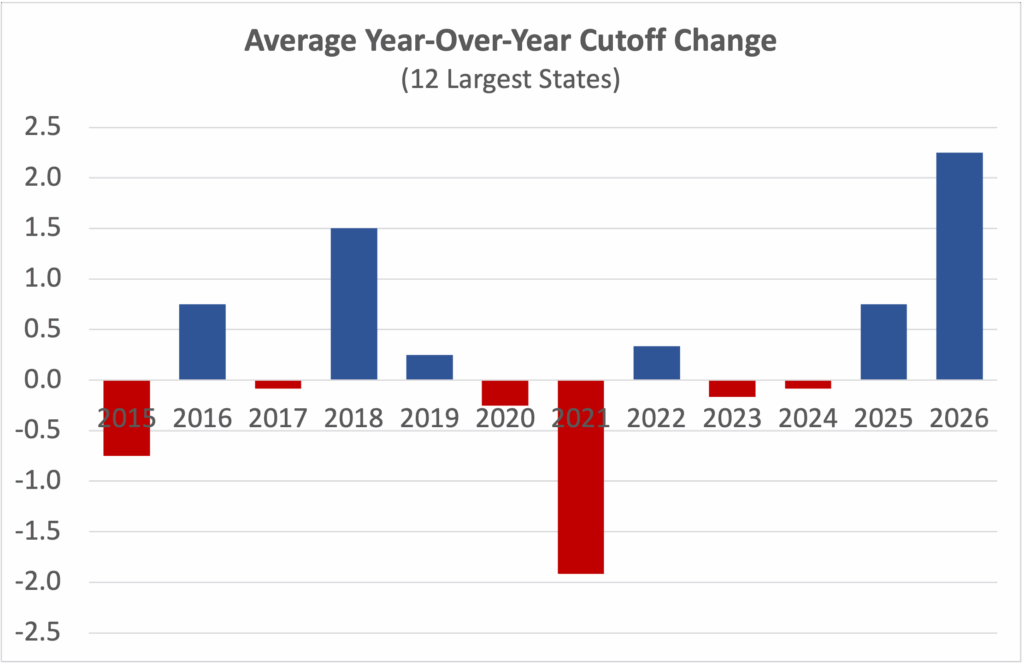
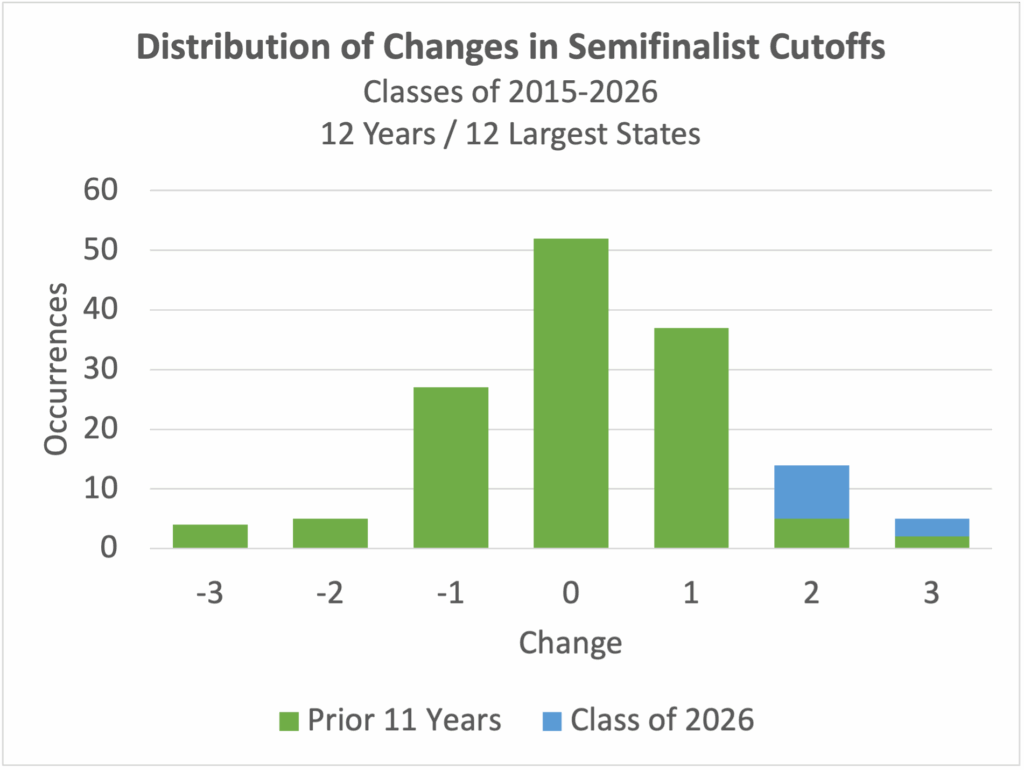
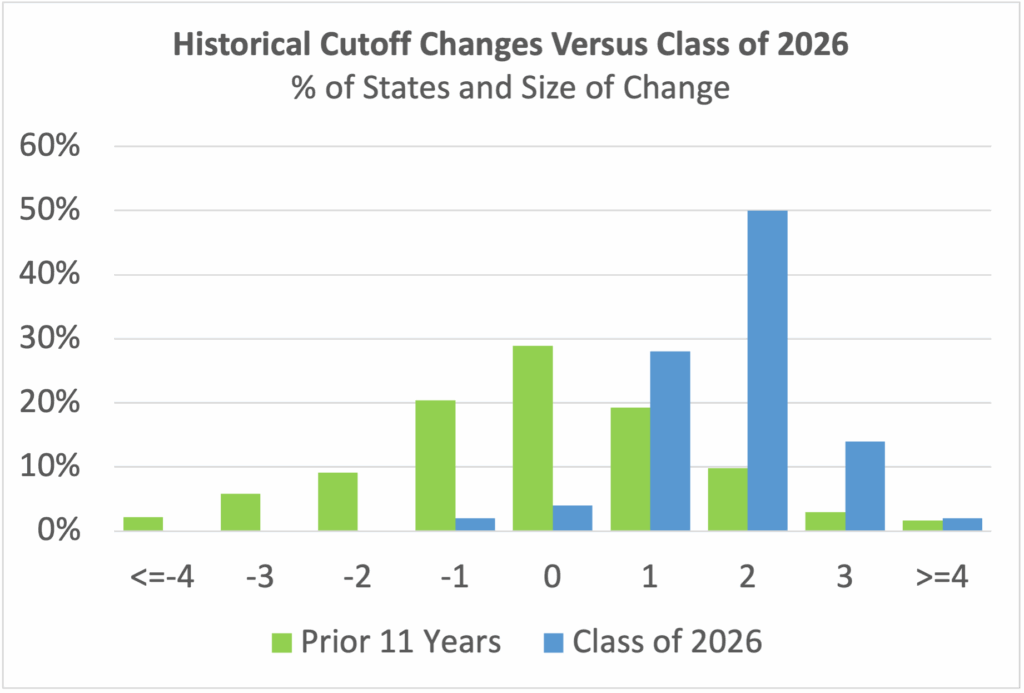
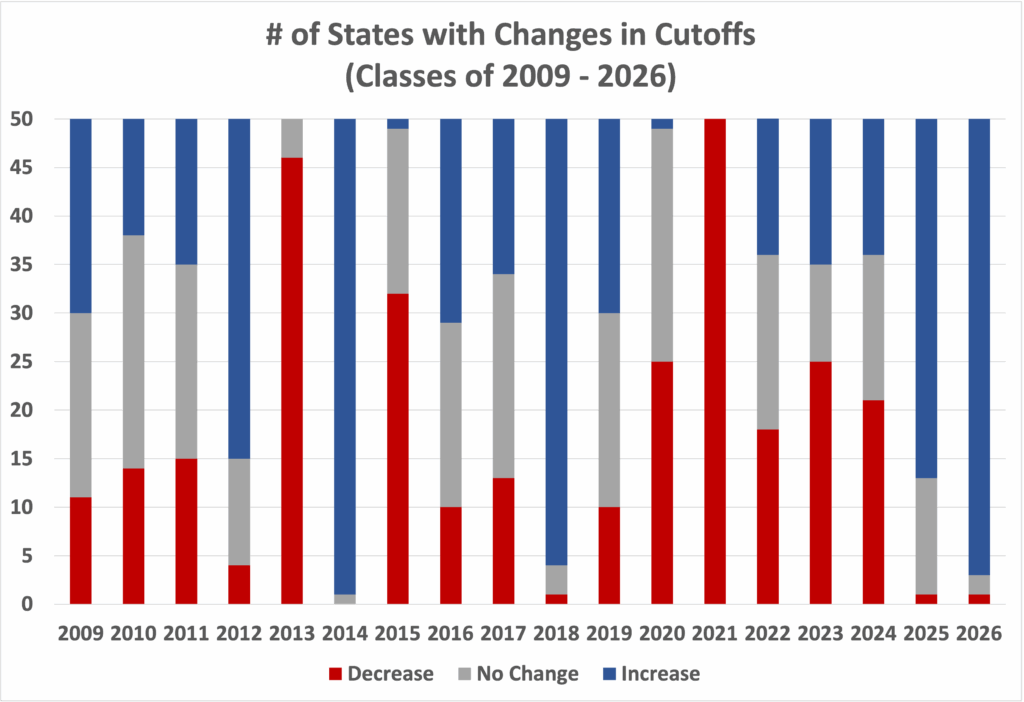
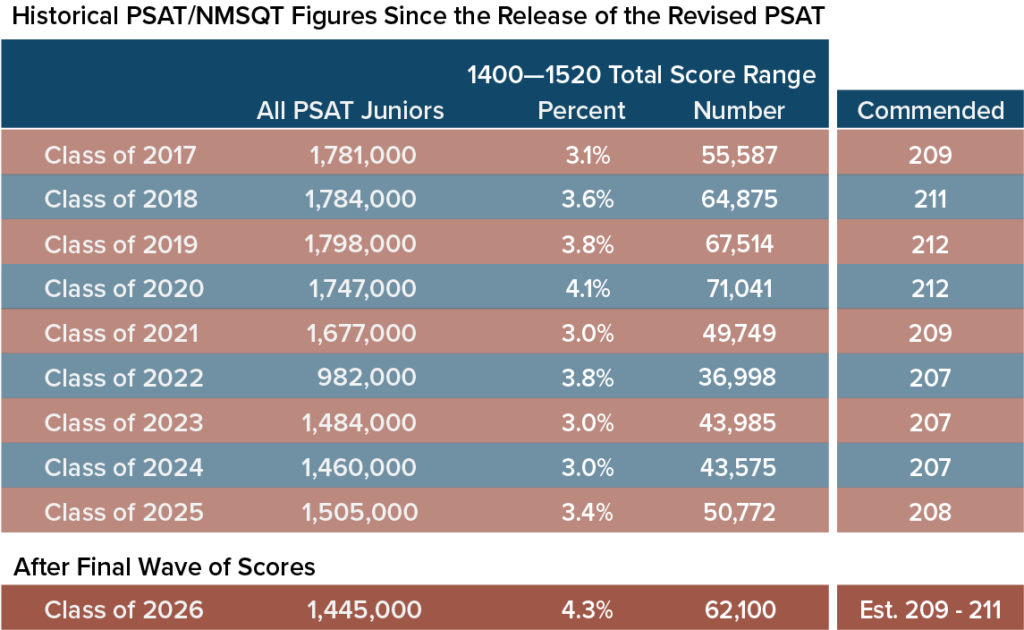
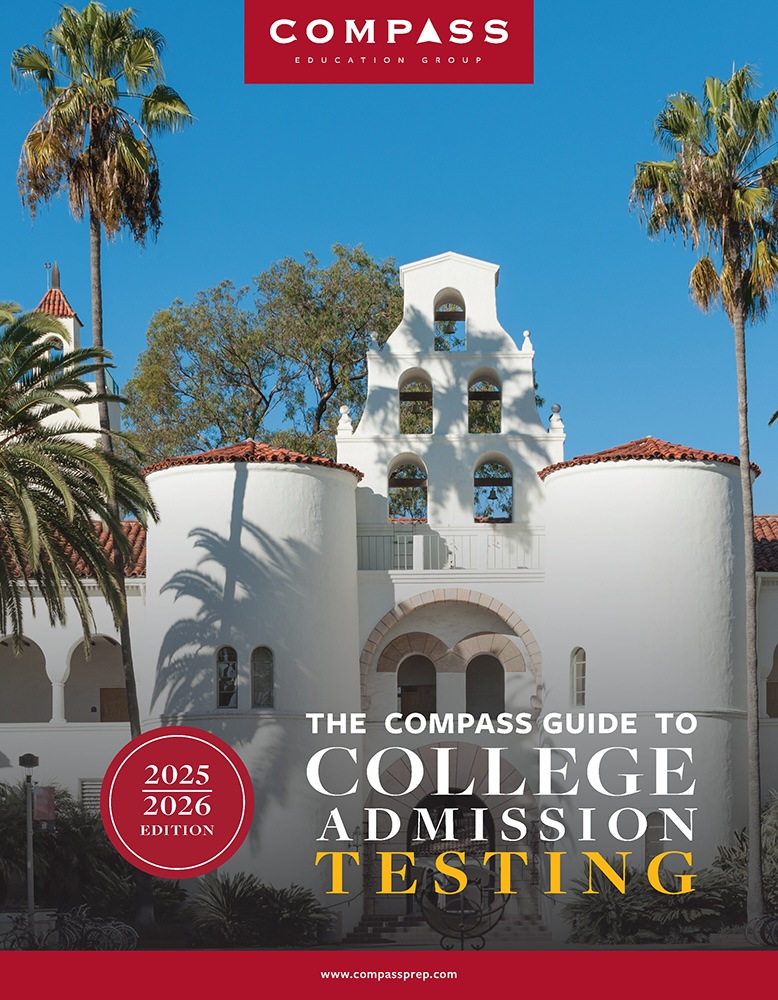
Connecticut is out. My child scored 223. The individual students were asked to keep their selection confidential until official reports to the media are made on September 15th listing who made it. While the cutoff is unclear, my child’s school had 4 semi-finalists and this school usually only has 1 student who reaches that benchmark. It may be that this class is a particularly strong one, but the cutoff may be simply lower than usual. Notably, every student in CT had an in-school SAT day, so there may be a number of students who qualified that way. Given the administration of the in-school SAT statewide, the number of CT SAT test-takers is likely very close to previous years.
Elizabeth,
Congratulations to your student! Yes, I suspect that CT’s cutoff will come in just a bit lower.
224 index, Texas. Public school.
Waiting for official confirmation before clicking submit on applications. Don’t want to jump the gun and make it appear I lied on the app calling myself a semifinalist.
You’re certainly safe, but it’s probably a good idea to see it in black-and-white. Congratulations.
My son has a 223 SI in Texas. Would he be safe as well? Is there any word on SI in TX?
Yes, 223 is very safe in TX. I’ve heard reports of 219 on other sites.
I read on college confidential that KY has a max cutoff of 213. Is this true or confirmed?
Molly,
That would be based on a student report, which I’ve found reliable.
Just got my letter from my principal, max cutoff in Alabama is 214. I had a 215, but the lowest scorer that got NMSF at my school had a 214 SI.
Congratulations, Mason! I’ll update the post.
Is 214 confirmed? Unfortunately, my daughter has a 213 in Alabama. Thank you for the information.
Right now all I know is that a student with 214 qualified. We don’t yet know if the actual cutoff is lower.
Hello Art,
Do you know the cut off for Florida? Thank you
Patricia,
Florida came in at 217 this year.
Waiting to hear in Colorado. son got 222. Any word yet?
No word on CO, Vicky, but I certainly like the chances of a 222.
Also waiting on NY. My son had a 219 SSI, so he is on the bubble.
My child received her NMSF letter in Ohio with a score of 220. A friend of hers at the same school got a score of 215 or 216 and received a NMSF letter as well . Sorry that I can’t remember the exact number. I just know they were 4 or 5 points less on their selection index score than my daughter when they shared that info previously.
Congratulations to your student, Kay. I’ll mark that down as a <=216 with an asterisk. Thank you.
My daughters friend did indeed get semifinalist with an index score of 215 in Ohio. Confirmed it w/ her parent tonight for you.
Great! Thanks, Kay.
Hello! If it is possible could you try to find out what her friends score was. I have a 215 SI and am so nervous!
Thank you:)
Riya,
Kay confirmed the 215 with the parent as of this evening (9/1).
Any news on South Carolina?
Not yet, Sofia. Please let us know if you get word!
Hello Art, do you think a selection index of 219 will make the cutoff in Texas? I have seen multiple reports of 219 making it on other forums, so just wanted to ask you!
I have no reason to doubt those reports, but I don’t have any additional information.
Hey Art, do you think that 219 will make the cutoff in Texas? Thank you.
Mike,
I’ve seen the reports of 219 on other sites, but I don’t have any additional confirmation.
Made Semi-Finalist in DE with an index of 221.
Congratulations, Violet! Thank you for sharing the information.
My son received his letter today and he is at 223. This is for Ohio.
Congratulations to your son, Melissa. I’m glad to hear that schools are getting the word out (or even better if he is home schooled!).
Anything from Virginia yet? Son got a 221.
Not yet, VAMom.
The letter students are receiving today are coming from the school district and/or principals of the high schools, correct? Meaning some kids in PA might have gotten letters today and some might not have? I think my HS SR is safely about the PA cut line, but anxiously waiting for confirmation.
Yes, a packet of letters is mailed to each high school (or home school). It’s up to the school to decide how and when to get the letters to students. Practices vary widely.
Though I personally haven’t seen the letter, my college counselor informed me today to expect an email coming with information about how to proceed as a NM Semifinalist (as the school received the letters, and I guess they want to write some fancy stuff up before giving them to us). I got a 221 index score in NC, so I’m not sure about how useful this information is to you (I’d expect a 218 at best in NC), but I guess at least it’s some starting point.
Congratulations, Jonathan. Information is always helpful for those still waiting for confirmation from their schools.
HS Counselor in CO here–two of our students with a 217 qualified. A 215 did not qualify. No student at our school had an SI of 216.
Thank you, Linda. I’ll update the post to reflect 216 or 217 as the CO cutoff.
I have a semi finalist in Arkansas with a 212
Congratulations to your NMSF, Holly!. Updating the post now.
Principal confirmed NMSF status today! SI of 224 in MD! Cutoff is likely lower, but at least we know it isn’t above 224, fwiw 🙂
That was a pretty safe bet, but I’m glad your wait is over. Congratulations! Thank you.
Hello. What if a student took the PSAT at a school other than their own due to covid. She has an index that should meet California criteria but hasn’t heard anything yet. Is it possible it got sent to the school she took it at instead of her own? Thanks
TTT,
The school that a student attends would receive the information. It is not at all unusual for students to have not received word yet. Some schools wait until mid-September! I’d give it another week and then make a polite inquiry to the college counselor.
212 max confirmed KY score. My son received notice from his school.
Thanks, Vernon. Best of luck to your son on his Finalist application!
Hello, Mr. Sawyer –
Any news on the cutoff for Iowa?
Deb,
I don’t have any direct reports.
Hi Art,
Thank you so much for these updates! I see your list includes Missouri <=215. I didn't see any comments from Missouri, so I assume you learned this from a different credible source? My D22 has a 218 and I'm on pins & needles. Thanks again.
JilliO,
It came from an earlier comment by a parent reporting on a Reddit post, so I don’t have independent confirmation. Can’t imagine that MO is setting new highs this year, so 218 seems solid. I know that probably doesn’t remove the pins or the needles. Good luck!
Hi, Art,
My student in Nebraska got his letter today. He had a 216 and thinks the cut off was 211.
Congratulations to your student! I’ve updated the post with his information.
Hi Art,
Is there only one report to your knowledge that the CA cutoff is not 220? I ask because there’s conflicting information on student forums.
That’s right, Frances. I’ll be all too happy to correct it if it’s incorrect.